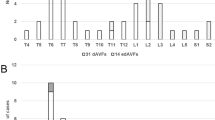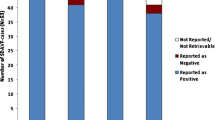Abstract
Spinal extradural arteriovenous fistulas (SEDAVFs) are a rare form of spinal arteriovenous fistulas, the etiology of which has not been completely elucidated. To our knowledge, this is the first reported case of SEDAVF that may have been caused by a spinal procedure. This report describes a 50-year-old female patient who presented with an SEDAVF at the L3/4 level that developed 3 years after a transforaminal epidural block due to disc extrusion, after which she underwent no other operation or trauma. From routine spine magnetic resonance imaging, disc sequestration was considered more likely than vascular malformation. However, on lumbar CT angiography (CTA) and three-dimensional volume rendering images (3D-VRI), the lesion showed good association with arteries of the aortic branches, allowing us to confirm the exact diagnosis of the lesion as SEDAVF. A limitation of 3D-VRI reconstruction is the difficulty in separate visualization of the vertebral body and blood vessels. On follow-up CTA, 3D dual-energy computed tomography (DECT) depicted smaller vascular structures and showed their anatomical relationships to the bone. While spinal angiography has been traditionally known as the gold standard for SEDAVF diagnosis, CTA with 3D-VRI, especially obtained by DECT, allows clinicians to make an accurate diagnosis and treatment plan that are difficult to judge by routine MRI.







Similar content being viewed by others
References
TaKai K. Spinal arteriovenous shunts: angioarchitecture and historical changes in classification. Neurologia medico-chirurgica. 2017:ra. 2016–0316.
Rangel-Castilla L, Holman PJ, Krishna C, Trask TW, Klucznik RP, Diaz OM. Spinal extradural arteriovenous fistulas: a clinical and radiological description of different types and their novel treatment with Onyx. J Neurosurg Spine. 2011;15(5):541–9.
Chaudhary N, Gemmete JJ. Endovascular management of neurovascular pathology in adults and children, An Issue of Neuroimaging Clinics, E-Book. vol 4. Elsevier Health Sciences; 2013.
Lai P, Weng M, Lee K, Pan H. Multidetector CT angiography in diagnosing type I and type IVA spinal vascular malformations. Am J Neuroradiol. 2006;27(4):813–7.
Lacombe P, Lacout A, Marcy P-Y, Binsse S, Sellier J, Bensalah M, et al. Diagnosis and treatment of pulmonary arteriovenous malformations in hereditary hemorrhagic telangiectasia: an overview. Diagnostic and interventional imaging. 2013;94(9):835–48.
Murakami T, Nakagawa I, Wada T, Kichikawa K, Nakase H. Lumbar spinal epidural arteriovenous fistula with perimedullary venous drainage after endoscopic lumbar surgery. Interv Neuroradiol. 2015;21(2):249–54.
Rasouli MR, Rahimi-Movaghar V, Vaccaro AR. Spinal arteriovenous fistulas. Arteriovenous Fistulas: Diagnosis and Management. 2013;105.
Lim S, Choi I. Spinal epidural arteriovenous fistula: a unique pathway into the perimedullary vein: a case report. Interv Neuroradiol. 2009;15(4):466–9.
Kinoshita M, Asai A, Komeda S, Yoshimura K, Takeda J, Uesaka T, et al. Spontaneous regression of a spinal extradural arteriovenous fistula after delivery by cesarean section. Neurol Med Chir. 2009;49(7):313–5.
Kiyosue H, Matsumaru Y, Niimi Y, Takai K, Ishiguro T, Hiramatsu M, et al. Angiographic and clinical characteristics of thoracolumbar spinal epidural and dural arteriovenous fistulas. Stroke. 2017;48(12):3215–22.
Ortega-Suero G, Etessam JP, Gamazo MM, Rodríguez-Boto G. Spinal arteriovenous fistulas in adults: management of a series of patients treated at a neurology department. Neurología (English Edition). 2018;33(7):438–48.
Coronado R, Hudson B, Sheets C, Roman M, Isaacs R, Mathers J, et al. Correlation of magnetic resonance imaging findings and reported symptoms in patients with chronic cervical dysfunction. Journal of Manual & Manipulative Therapy. 2009;17(3):148–53.
Nievas MNC, Hoellerhage H-G. Unusual sequestered disc fragments simulating spinal tumors and other space-occupying lesions. J Neurosurg Spine. 2009;11(1):42–8.
Jeng Y, Chen DY-T, Hsu H-L, Huang Y-L, Chen C-J, Tseng Y-C. Spinal dural arteriovenous fistula: imaging features and its mimics. Korean J Radiol. 2015;16(5):1119–31.
Fellner FA, Fellner CM, Chapot R, Akbari K. MR visualization of spinal dural arterio-venous fistula using T2-weighted 3D SPACE—a spin-echo technique. J Biomed Sci Eng. 2015;8(05):327.
Si-jia G, Meng-wei Z, Xi-ping L, Yu-shen Z, Jing-hong L, Zhong-hui W, et al. The clinical application studies of CT spinal angiography with 64-detector row spiral CT in diagnosing spinal vascular malformations. Eur J Radiol. 2009;71(1):22–8.
Petritsch B, Kosmala A, Weng AM, Krauss B, Heidemeier A, Wagner R, et al. Vertebral compression fractures: third-generation dual-energy CT for detection of bone marrow edema at visual and quantitative analyses. Radiology. 2017;284(1):161–8.
Vlahos I, Chung R, Nair A, Morgan R. Dual-energy CT: vascular applications. American Journal of Roentgenology. 2012;199(5_supplement):S87–97.
Dappa E, Higashigaito K, Fornaro J, Leschka S, Wildermuth S, Alkadhi H. Cinematic rendering–an alternative to volume rendering for 3D computed tomography imaging. Insights into imaging. 2016;7(6):849–56.
Zhang H, He M, Mao B. Thoracic spine extradural arteriovenous fistula: case report and review of the literature. Surg Neurol. 2006;66:S18–23.
Maimon S, Luckman Y, Strauss I. Spinal dural arteriovenous fistula: a review. Advances and technical standards in neurosurgery. Springer; 2016. p. 111–37.
Endo T, Endo H, Sato K, Matsumoto Y, Tominaga T. Surgical and endovascular treatment for spinal arteriovenous malformations. Neurol Med Chir. 2016;56(8):457–64.
Acknowledgments
We thank Mr. Jaewon Choi, application specialist at Siemens Healthineers, Korea, for his help in obtaining reconstructed images. We also greatful to Dr. JungHyun Park, department of neurosurgery (subspeciality of endovascular neurosurgery) at Hallym University Dongtan Sacred Heart hospital, for his help the diagnosis of SEDAVF.
Author information
Authors and Affiliations
Corresponding author
Ethics declarations
Conflict of interest
The authors declare that they have no conflict of interest.
Additional information
Publisher’s note
Springer Nature remains neutral with regard to jurisdictional claims in published maps and institutional affiliations.
Rights and permissions
About this article
Cite this article
Kim, A.Y., Khil, E.K., Choi, I. et al. Spinal extradural arteriovenous fistula after lumbar epidural injection: CT angiographic diagnosis using 3D-volume rendering. Skeletal Radiol 49, 2073–2079 (2020). https://doi.org/10.1007/s00256-020-03504-x
Received:
Revised:
Accepted:
Published:
Issue Date:
DOI: https://doi.org/10.1007/s00256-020-03504-x




